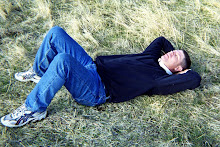I remember when I first started reading the Bible, really reading it. When I was young the Bible was read to me at church and revered in the home, but I didn't begin perusing its rich library of literature until high school. I recall the mixed joy and frustration as I worked my way through the Pentateuch, marveled at the wonder and mystery of the Bible’s apocalyptic literature, and learned from the profound yet practical theology of the epistles. It’s a journey of discovery I’m still on today.
I’ve been on another journey of discovery lately—a journey into the world of fine art. I used to think of art as mere decoration, something pleasing to look at. When I was a child I thought Norman Rockwell was the greatest artist in the world and spent hours leafing through the coffee table book we had of his illustrations in our family’s home. Later I graduated to Monet’s Water Lilies and other images I found “pretty.”
I’ve been learning that art is more than aesthetics, a lot more than mere decoration. Art is as varied as life itself. And, like the Bible, art can be mesmerizing, thought provoking, frightening, inspiring, funny, confusing, convicting, offensive, and so much more. I’m awed by the variety of art and its ability to speak to me, if I let it.
When I first began studying the Bible, I needed a lot of help to understand, like the Ethiopian eunuch sitting in his chariot (Acts 8:26-40). Commentaries, study Bibles, and other helps served as my guides and still do. Whenever I came across a passage I found troubling or difficult, I was quick to find a way to lessen the tension, often explaining away the problem for my own comfort’s sake. (Jesus didn’t really mean sell all you have, did he? Of course not!) Now when I read the Bible I look for those things that confuse, trouble, or even offend me. Usually there’s a teachable moment, and if I listen, I’ll hear God speak.
Just as I've found a new way of reading the Bible, I've develop a new approach to art. I used to shun all modern art. When I saw an abstract painting or sculpture, I’d think to myself, “That’s not real art” and turn away. I’m learning to look a little longer and ask a few questions: Who was the artist and what was she trying to say? Was she reacting against something? What genre or school of art is it from and how does it fit into that tradition? Is there anything new or unexpected here, if so what?
As part of my effort to learn how to appreciate art more, I recently read a book by Michael Kimmelman called The Accidental Masterpiece. It’s a good book, but one small passage had a bigger impact on me than any other: “Art is about a heightened state of awareness. Try to treat everyday life, or at least parts of it, as you would a work of art.” Art is about learning to see.
It’s also about learning to listen. A few days ago I read this passage from Thomas Merton:
Music is pleasing not only because of the sound but because of the silence that is in it: without the alternation of sound and silence, there would be no rhythm. If we strive to be happy by filling in the silences of life with sound, productive by turning all life’s leisure into work, and real by turning all our being into doing, we will only succeed in producing a hell on earth. If we have not silence, God is not heard in our music. If we have not rest, God does not bless our work. If we twist our lives out of shape in order to fill every corner of them with action and experience, God will seem silently to withdraw from our hearts and leave us empty.
Immediately my mind turned to the avant-garde composer John Cage, whose 1952 work 4’33” is made up of three movements without a single note. When he performed this piece he just sat at the piano and played nothing. I used to think that was a stupid gimmick—musical chicanery meant to impress gullible pseudo-intellectuals. Now I’m wondering whether he was trying to say something similar to what Merton said: silence is as important to music as sound, and if you listen to silence you actually hear something. But you have to be a lot more attentive when listening to silence.
I also thought of the artist Robert Rauschenberg, famous for his collages and sculptures made with junk he found. Yes, literal trash. In 1953 he erased a painting by the famous abstract artist Willem de Kooning, probably the most famous artist at the time. The work is called Erased de Kooning. It’s simply a blank canvas that had once been full of color. Maybe one of the many things the mischievous artist was saying has to do with the importance of the empty space on a canvas. At least that’s one effect of this unique un-painting.
Don’t get me wrong; I still like Norman Rockwell. Some refined intellectuals look down their noses at him and consider his art mawkish, overly sentimental. The problem is those snobs haven’t looked closely enough at his oeuvre. I’d challenge them to take a look at Rockwell’s 1964 painting The Problem We All Live With, done at the height of the Civil Rights Movement. It’s one of the most striking social critiques by an artist.
So, I’m learning to look at art, if not life, a little more carefully. What have you noticed lately?

No comments:
Post a Comment